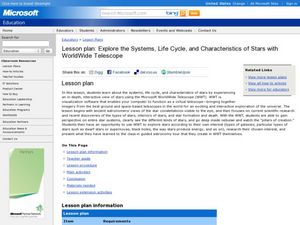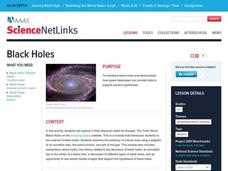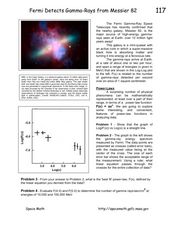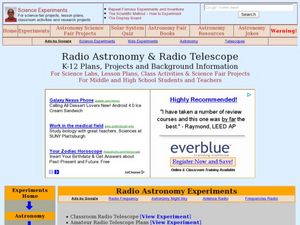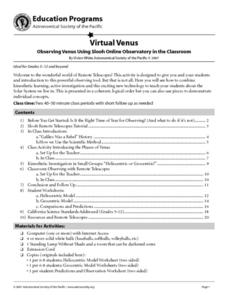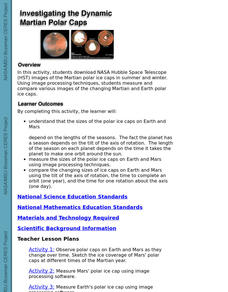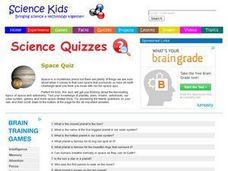NASA
Space Images
As technology advances, so does our understanding of the universe around us. Thanks to the Hubble Telescope, Mars rovers, and other high-resolution cameras, there are amazing photographs of celestial bodies, planets, comets, and more...
PBS
NOVA Sun Lab Lesson Plan
Looking for a sun-sational multi-lesson plan full of videos, simulations, and discussion? Introduce your young scientists to all things solar with a four-part hands-on adventure. Pupils learn the basics of solar anatomy, space weather,...
University of Colorado
Strange New Planet
The first remote sensors were people in hot air balloons taking photographs of Earth to make maps. Expose middle school learners to space exploration with the use of remote sensing. Groups explore and make observations of a new...
Curated OER
Explore the Characteristics of Stars with Microsoft WorldWide Telescope
Students explore the characteristics of stars. For this space science activity, students use the Microsoft WorldWide Telescope program to identify the properties of stars and identify the stars in the galaxy.
Curated OER
Online Exploration: Telescopes From the Ground Up
Students explore a web-based illustrated text and interactive graphics to determine the relationship between the operation of telescopes and light. optics. They work in small groups to become an expert on one of the ten eras of telescope...
Curated OER
Hubble Space Telescope
Students investigate the universe through the eyes of the Hubble space telescope. They conduct research from looking at the universe that is simulated with a digital projector. The images are projected onto the wall in a simulation of...
Curated OER
Spitzer Explores a Dusty Young Star
In this stars worksheet, students read about the Spitzer space telescope and they solve 5 problems about the mass, size, and power of dust grains and interstellar mediums detected by the telescope.
Curated OER
Black Holes
Learners study black holes and see how space telescopes can provide data to support current hypotheses. They examine the anatomy of a black hole using a diagram of an accretion disk, the event horizon, and jets of hot gas.
Curated OER
Spitzer Explores a Dying Star
In this dying star worksheet, students read about the Spitzer Space Telescope that detected the dying star-Messier-57. Students solve 6 problems including determining the total power produced by the dying star, they find the total mass...
Curated OER
Fermi Detects Gamma-Rays from Messier
For this power law function worksheet, students use data from the Fermi Gamma-Ray Space telescope to apply the power law function to physical phenomena. Students use a graph to solve four problems.
International Technology Education Association
Telescope as Time Machine
This resource provides an explanation of NASA's GALEX mission and how the space-based telescope can view distant galaxies as they were billions of years ago. The resource also discusses the other aspects of galaxies that GALEX...
Curated OER
Radio Astronomy and Radio Telescope
Learners construct a simple radio telescope. In this astronomy lesson, students explain how this telescope works and what information it collects.
Curated OER
Algebra: Mirror, Mirror on the Universe
Students assess how algebra, telescopes, space exploration and optics are so important in astronomy. They encounter studies on the Hubble Space Telescope, Hubble Deep Field and how algebra helps to determine the effects of contamination...
Curated OER
Virtual Venus
Students practice using the tool of remote telescopes in order to make observations in space. The lesson includes the best times of year to make observations. They use the internet to obtain information and to initiate the use of the...
Curated OER
Eye in the Sky
Students use the Internet to broaden their knowledge and understanding of the Hubble Space Telescope by participating in an Internet scavenger hunt, searching for information about the objectives, past successes and repair of the telescope.
Curated OER
Investigating the Dynamic Martian Polar Caps
Students download NASA Hubble Space Telescope images of the Martian polar ice caps in summer and winter, and measure and compare various images of the changing Martian and Earth polar ice caps.
Curated OER
Science: Space Quiz
In this science: space quiz learning exercise, students answer twenty questions, not interactively, about outer space, then scroll down to find the answers.
Messenger Education
Mission: Possible—How Can We Plan an Exploration of Another World?
An astronaut's spacesuit weighs 280 pounds and takes 45 minutes to put on — that's a serious suit! The second activity of a three-part series allows pupils to see all that goes into space exploration. Through simulations, groups analyze...
Curated OER
Looking into Space
Learners explore how telescopes work, build a model of their own, and consider how real telescopes can be used to ask-and help answer-questions about the universe.
Curated OER
Space Search
In this space worksheet, students identify and locate vocabulary terms and names related to space. There are 26 words located in the puzzle.
National Endowment for the Humanities
Galileo: Revealing the Universe
To gain an understanding of the significance of Galileo Galilei's revolutionary ideas, class members watch the short video "Stargazing Before Galileo," and conduct a close reading of Galileo's Sidereal Messsenger. They then...
Curated OER
Radiation From Space
In this space worksheet, students will review different aspects of light, sound, and radio waves in space and the use of different types of telescopes. This worksheet has 17 fill in the blank statements.
Curated OER
Observing the Outer Planets
Students observe the outer planets. In this science lesson, students use a telescope locate the outer planets of the solar system. Students create a video of their observations.
Curated OER
The Lesson: Space Exploration
Students explore space. For this current events lesson, students visit selected websites to learn about NASA, Mars, the Seti Institute, and space exploration terminology. Students make space glossaries and their own telescopes.





